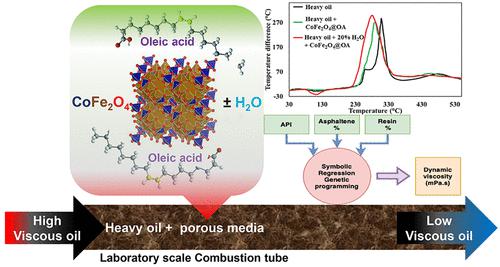当前位置:
X-MOL 学术
›
Ind. Eng. Chem. Res.
›
论文详情
Our official English website, www.x-mol.net, welcomes your
feedback! (Note: you will need to create a separate account there.)
Effect of Different Water Content and Catalyst on the Performance of Heavy Oil Oxidation in Porous Media for In Situ Upgrading
Industrial & Engineering Chemistry Research ( IF 3.8 ) Pub Date : 2022-06-23 , DOI: 10.1021/acs.iecr.2c01007 Seyedsaeed Mehrabi-Kalajahi 1, 2 , Fahimeh Hadavimoghaddam 3 , Mikhail A. Varfolomeev 1, 2 , Rana Salari 4 , Almaz L. Zinnatullin 5 , Farit G. Vagizov 5
Industrial & Engineering Chemistry Research ( IF 3.8 ) Pub Date : 2022-06-23 , DOI: 10.1021/acs.iecr.2c01007 Seyedsaeed Mehrabi-Kalajahi 1, 2 , Fahimeh Hadavimoghaddam 3 , Mikhail A. Varfolomeev 1, 2 , Rana Salari 4 , Almaz L. Zinnatullin 5 , Farit G. Vagizov 5
Affiliation

|
Enhanced heavy oil recovery by in situ combustion (ISC) is still restricted as an attractive thermal method because of difficulties with ignition, inefficient combustion, and unstable combustion fronts. This study illustrates how different water contents and CoFe2O4 nanoparticles coated with oleic acid (OA), individually and synergistically, can be used in heavy oil oxidation for enhanced oil recovery through ISC. By means of X-ray diffraction, field-emission scanning electron microscopy, transmission electron microscopy, and dynamic light scattering, we characterized the synthesized bimetallic oxide catalysts with and without oleic acid as a capping agent. The size of the CoFe2O4 and CoFe2O4@OA nanoparticles was evaluated by the ImageJ method in order to estimate the size distribution in different environments. The size–frequency analysis showed that the dimension of CoFe2O4 nanoparticles in the presence of oleic acid as a capping agent due to uniformity and well distribution decreased to an average size of ∼20 nm. The oxidation of the heavy oil was studied by a self-designed thermo-effect cell containing a porous medium (PMTEC) and a laboratory-scale combustion tube. According to the results, the addition of 20% water content compared to 10% and 30% water content, and oil-dispersed CoFe2O4@OA compared to CoFe2O4 nanoparticles led to a decrease in both low-temperature oxidation and high-temperature oxidation into lower temperatures through the reduction of energy barriers and the promotion of coke formation. The viscosity of recovered oil decreased from 2071 to 246 mPa·s after oxidation in porous media with a 20% water content and a CoFe2O4@OA catalyst. In addition, the SARA analysis showed that the oxidation of heavy oil in porous media with water content and catalyst reduced the heavy fractions such as resin and asphaltene contents from 20.9 and 5.9% to 9.7 and 2.5%, respectively, and increased the light fractions including saturate and aromatic contents from 28.7 and 44.3% to 41.3 and 46.5%, respectively. In addition, based on experimental data, a robust correlation was developed to predict oil viscosity using a genetic programming algorithm. The results showed that the developed method could predict oil viscosity with enough accuracy. On the basis of the viscosity reduction data, the combustion efficiency of heavy oil is in turn: heavy oil + CoFe2O4@OA > heavy oil + CoFe2O4 > heavy oil + CoFe2O4@OA + 20% H2O > heavy oil +20% H2O > heavy oil +10% H2O > heavy oil +30% H2O > heavy oil.
中文翻译:

不同含水量和催化剂对多孔介质中稠油氧化原位改质性能的影响
由于点火困难、燃烧效率低和燃烧前沿不稳定,通过原位燃烧(ISC)提高稠油采收率作为一种有吸引力的热方法仍然受到限制。本研究说明了不同的含水量和涂有油酸 (OA) 的 CoFe 2 O 4纳米颗粒如何单独和协同地用于重油氧化,以通过 ISC 提高采收率。通过 X 射线衍射、场发射扫描电子显微镜、透射电子显微镜和动态光散射,我们表征了有和没有油酸作为封端剂的合成双金属氧化物催化剂。CoFe 2 O 4和CoFe 2 O 4的尺寸@OA 纳米粒子通过 ImageJ 方法进行评估,以估计不同环境中的尺寸分布。尺寸-频率分析表明,在油酸作为封端剂存在的情况下,CoFe 2 O 4纳米颗粒的尺寸由于均匀性和良好分布而减小到平均尺寸~20 nm。通过自行设计的包含多孔介质 (PMTEC) 和实验室规模燃烧管的热效应池研究重油的氧化。根据结果,添加 20% 的水含量与 10% 和 30% 的水含量相比,油分散的 CoFe 2 O 4 @OA 与 CoFe 2 O 4相比纳米颗粒通过降低能量势垒和促进焦炭形成,导致低温氧化和高温氧化降低到较低温度。在含水量为 20% 和 CoFe 2 O 4的多孔介质中氧化后,采油粘度从 2071 降至 246 mPa·s@OA 催化剂。此外,SARA 分析表明,重油在含水量和催化剂的多孔介质中氧化使树脂和沥青质等重质馏分的含量分别从 20.9% 和 5.9% 降低到 9.7% 和 2.5%,并增加了轻质馏分,包括饱和和芳烃含量分别从 28.7% 和 44.3% 提高到 41.3% 和 46.5%。此外,基于实验数据,开发了一种稳健的相关性,以使用遗传编程算法预测油的粘度。结果表明,所开发的方法可以足够准确地预测油的粘度。根据降粘数据,重油的燃烧效率依次为:重油+CoFe 2 O 4 @OA > 重油+CoFe 2 O 4> 重油 + CoFe 2 O 4 @OA + 20% H 2 O > 重油 +20% H 2 O > 重油 +10% H 2 O > 重油 +30% H 2 O > 重油。
更新日期:2022-06-23
中文翻译:

不同含水量和催化剂对多孔介质中稠油氧化原位改质性能的影响
由于点火困难、燃烧效率低和燃烧前沿不稳定,通过原位燃烧(ISC)提高稠油采收率作为一种有吸引力的热方法仍然受到限制。本研究说明了不同的含水量和涂有油酸 (OA) 的 CoFe 2 O 4纳米颗粒如何单独和协同地用于重油氧化,以通过 ISC 提高采收率。通过 X 射线衍射、场发射扫描电子显微镜、透射电子显微镜和动态光散射,我们表征了有和没有油酸作为封端剂的合成双金属氧化物催化剂。CoFe 2 O 4和CoFe 2 O 4的尺寸@OA 纳米粒子通过 ImageJ 方法进行评估,以估计不同环境中的尺寸分布。尺寸-频率分析表明,在油酸作为封端剂存在的情况下,CoFe 2 O 4纳米颗粒的尺寸由于均匀性和良好分布而减小到平均尺寸~20 nm。通过自行设计的包含多孔介质 (PMTEC) 和实验室规模燃烧管的热效应池研究重油的氧化。根据结果,添加 20% 的水含量与 10% 和 30% 的水含量相比,油分散的 CoFe 2 O 4 @OA 与 CoFe 2 O 4相比纳米颗粒通过降低能量势垒和促进焦炭形成,导致低温氧化和高温氧化降低到较低温度。在含水量为 20% 和 CoFe 2 O 4的多孔介质中氧化后,采油粘度从 2071 降至 246 mPa·s@OA 催化剂。此外,SARA 分析表明,重油在含水量和催化剂的多孔介质中氧化使树脂和沥青质等重质馏分的含量分别从 20.9% 和 5.9% 降低到 9.7% 和 2.5%,并增加了轻质馏分,包括饱和和芳烃含量分别从 28.7% 和 44.3% 提高到 41.3% 和 46.5%。此外,基于实验数据,开发了一种稳健的相关性,以使用遗传编程算法预测油的粘度。结果表明,所开发的方法可以足够准确地预测油的粘度。根据降粘数据,重油的燃烧效率依次为:重油+CoFe 2 O 4 @OA > 重油+CoFe 2 O 4> 重油 + CoFe 2 O 4 @OA + 20% H 2 O > 重油 +20% H 2 O > 重油 +10% H 2 O > 重油 +30% H 2 O > 重油。











































 京公网安备 11010802027423号
京公网安备 11010802027423号